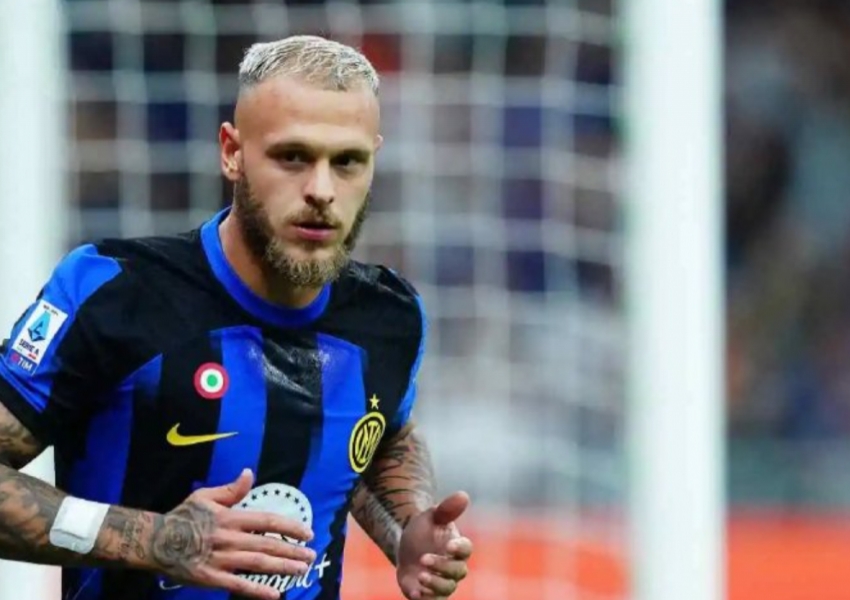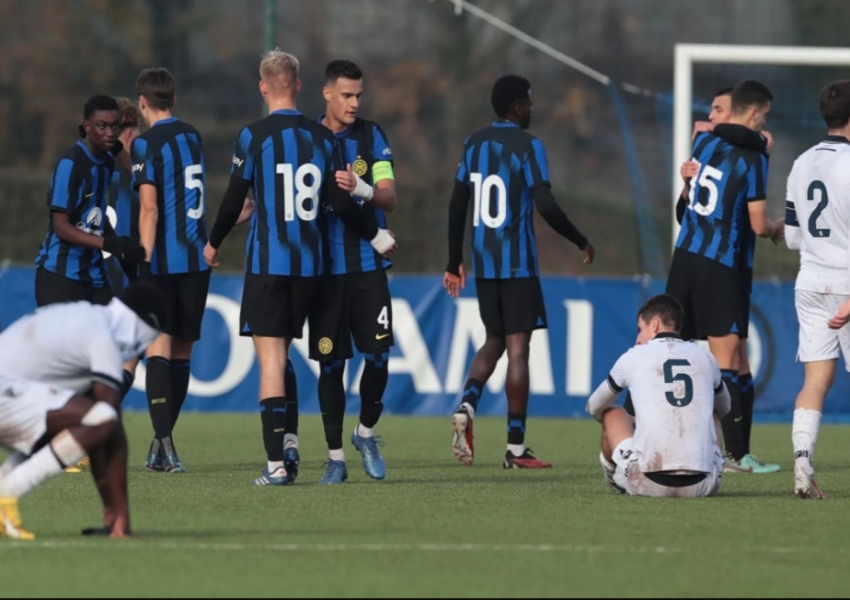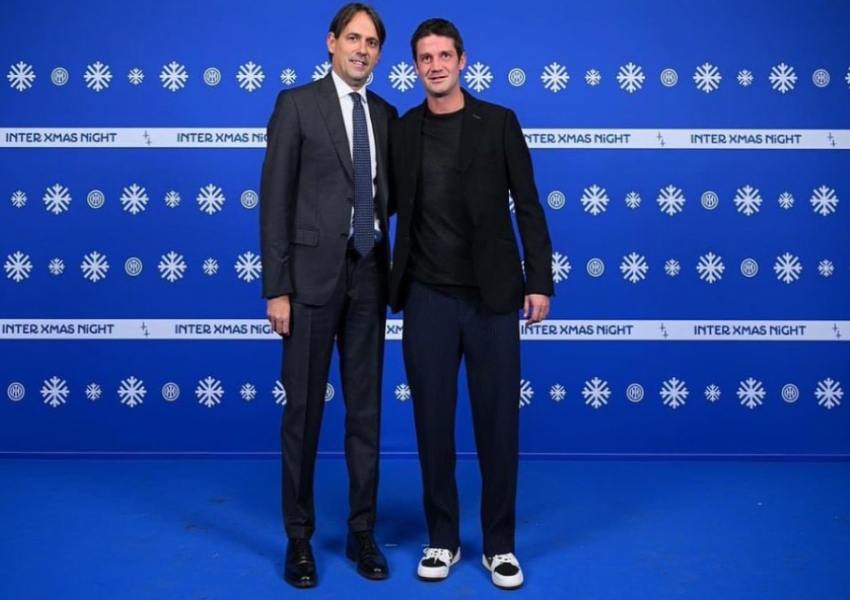Inter Milan's Stability Amid Leadership Changes: Triple Crown Hero Reaches the Summit After 2.5 Years, New Di Marco on the Horizon
In the wake of Lautaro Martinez's injury, Federico Di Marco has also joined Inter Milan's injury list and is expected to be sidelined for 1-2 weeks. This has stirred discontent among fans, who question whether it's worth losing key players for the Coppa Italia. However, it's essential to note that Di Marco's injury cannot be entirely blamed on rotation issues, as he only played a brief substitute role in the cup match. This season, Di Marco has been relatively well-rotated, clocking 1,313 minutes across all competitions, ranking ninth on the team, not far ahead of his backup Carlos Augusto with 1,047 minutes. Injuries can't solely be attributed to rotation.

Given the congested fixture schedule, injuries are inevitable for big clubs like Manchester City, Real Madrid, and AC Milan. Another notable event is the resounding 4-1 victory of Inter's youth team under Cristian Chivu, securing top position as they conclude their 2023 campaign. Since the seventh round of this season, Chivu's team has led the league, marking their return to the top spot in the youth league for the first time since May 2021. While youth team success is not the primary objective—the goal being player development rather than winning—the recent changes in Inter's youth setup are encouraging. This demonstrates that Inter is resilient and not doomed to mediocrity despite financial difficulties and key departures.

This summer, long-serving youth academy head Roberto Samaden left Inter despite efforts to retain him. Some pessimists pointed to Inter's financial woes and reduced youth budget as reasons for his departure, predicting doom for the club. However, in the most comprehensive indicator of a team's overall strength—the league—Inter's youth team has shown a resurgence this season. Last season, they were mid-table, but now they exhibit the strongest vitality in recent years, a testament to Chivu and his players' efforts.

The Nord curve often claims, "Milan has two great teams: Inter Milan and Inter Milan's second team." This saying, although contentious, highlights the historical depth of Inter's youth setup. Over the past three months, 16 players from Inter's youth team have been called up to national youth teams of Italy, Poland, Ireland, and Serbia at the U17 level and above. While none may yet have the clear star potential of a young Mario Balotelli, the sheer number of call-ups indicates a promising pool of talent. It may not yield a new Messi, but producing another Di Marco seems realistic, a sentiment shared confidently by Chivu and his staff.
Following Samaden's departure, Inter appointed Massimo Tarantino as the new head of the youth academy. Tarantino has initiated several changes, ranging from training methods to tactical approaches, embodying a philosophy best described as "semplici" (natural, simple). Specifically, training no longer focuses heavily on scouting opponents and devising counter-strategies. Instead, Chivu and his staff concentrate on developing their players' skills. The primary objective of the youth team is to foster player growth, not merely to win matches through tactical maneuvers.
These changes have coincided with significant improvements in performance. Regular viewers of youth team matches have observed notable progress in several players, illustrating the potential and adaptability of young athletes when given the right guidance. The tactical shift to a 4-3-3 formation, moving away from the 3-5-2 system enforced in previous years to align with the senior team's needs, reflects Tarantino's philosophy that the system should suit the players' natural abilities.
However, this divergence in tactical setups between the youth and senior teams poses challenges. The idea of directly promoting youth players to fill gaps in the senior squad becomes more complex. For instance, a center-back accustomed to a four-man defense in the youth team might struggle to adapt to a three-man defense in the senior team. Similarly, a winger or full-back from the youth team might find it difficult to transition into a wing-back role. This tactical disparity is a significant reason why Simone Inzaghi has not fielded youth players in the senior team this season, answering fans' questions about why youth players haven't been utilized in the Coppa Italia.
Despite these challenges, the current approach is beneficial in the long run. Given Inter's financial constraints, the youth team cannot rely on expensive transfers of semi-developed talents. The previous batch of promising players, such as Cesare Casadei, Nicolò Fabbian, and Franco Mulattieri, have already been sold or loaned out. Therefore, Inter needs to cultivate a new generation of talents who can either be sold for profit or serve as valuable assets for the senior team.
Since the turn of the century, Inter's youth academy has generated over €500 million through player sales, a critical revenue stream for the club. Now, the academy is entering a new cycle of development, sowing seeds with the hope of reaping a bountiful harvest in the future. Encouragingly, the process is progressing well.
The commitment to fostering talent is evident. Inter’s youth team, once mid-table strugglers, now lead the league, demonstrating the effectiveness of the new training methods and tactical flexibility. This resurgence underlines the importance of nurturing young talents, not just for immediate success but for sustainable growth and future contributions to the senior team.
Inter's youth academy, under the new leadership of Tarantino, is focused on the long-term development of players. The shift to a simpler, more natural approach has allowed players to grow and develop without the burden of overly tactical constraints. This philosophy has not only improved individual performances but has also translated into better team results, proving that focusing on player development can yield positive outcomes both on and off the field.
The new training regimen, emphasizing skill enhancement over opponent nullification, has shown remarkable results. Players who were previously average have made visible progress, highlighting the importance of targeted training and development. This approach ensures that the youth academy's primary goal—producing talented players—is achieved, laying a solid foundation for the future.
Tactically, the switch to a 4-3-3 formation reflects a return to fundamentals, allowing players to express their natural abilities. This system has brought out the best in many players, showcasing their strengths and improving their overall game. Although it creates challenges when integrating these players into the senior team's different system, it ultimately prepares them better for professional football.
The discrepancy between the youth and senior teams' tactical setups presents integration challenges. Young defenders used to a four-man backline might find it hard to adapt to a three-man defense in the senior team. Similarly, wingers and full-backs may struggle to transition into wing-back roles. These issues have influenced Inzaghi's decision to limit youth player promotions this season.
Nonetheless, the focus on developing individual talent over immediate tactical conformity is a positive shift. Financially constrained, Inter cannot afford to buy ready-made talents. Instead, they must rely on their youth academy to produce future stars. The current crop of youth players shows promise, and their development is crucial for the club's future, whether they become first-team regulars or valuable transfer assets.
Historically, Inter's youth academy has been a vital source of revenue, generating significant funds through player sales. The current phase of talent cultivation is essential for sustaining this model. With promising young players in the pipeline, Inter can look forward to future financial and sporting success.
In conclusion, the changes implemented by Tarantino have revitalized Inter's youth academy. The focus on player development, combined with a more natural tactical approach, has yielded positive results. Despite the challenges posed by differing tactical systems, the emphasis on individual growth ensures a steady supply of talented players for the future. Inter's youth academy is on the right track, poised to continue its tradition of producing top-quality players and contributing to the club's overall success.
Copyright Statement:
Author: mrfootballer
Source: Mrfootballer
The copyright of this article belongs to the author. Reproduction is not allowed without permission.
Recommended Blog
- Primeira Liga Round 15 Preview: Benfica's Defense Faces Minimal Pressure, Porto Urgently Chasing Points and Goal Difference
- Inter's Transfer Dilemma: Choosing Between Buchanan and Taremi Amid Tax Break Changes
- A-League Round 10: Can Melbourne City Reclaim Their Regular Season Crown? Wellington Phoenix's Efficient Chain Defense
- Inter Milan Aiming for Mid-Season Title: Thuram Challenges a Curse, Potential New Signing Seeks Redemption
- Premier League Matchday 19: Haaland's Fatigue from Travel, Who Can Chelsea Rely On?
- Inter Milan's New Forward in the Fold? Key Move Reveals Potential New Dimarco Amidst Wing-Back Deal Talks
- Championship Round 24 Preview: Leicester City Ending Title Race Early? Leeds United's Dominance Emerges
- Inter Milan's Midfield Battle Decided? Two Major Winter Window Exits Revealed
- Post-2000 Players Finally Shed Inter Milan’s Shame as Young Talent Shines
- Premier League Round 18: Liverpool Embraces the Festive Spirit, Everton's Solid Defense Complete
Hot Blog
- English Media: Manchester United Will Win Premier League Title in 2028! History Will Repeat Itself, Two Teams Serve as Inspirations
- 0-2 Double Defeat! China National Team Stuck at 6 Points: No More Direct World Cup Hopes, Two Crucial Matches Ahead
- 4 AM Showdown: Barcelona's Revenge Match! Win = 3-Point Lead Over Real Madrid, Key Players Rested
- China National Football Team Drops 13.6 Points, Slips to 94th in FIFA Rankings: Syria Overtakes, New 9-Year Low
- 0-0 Draw! Japan 12 Shots, 2 Missed One-on-Ones: 8 Matches, 20 Points, Group Winner, Saudi Arabia Stuck at 10 Points in 3rd
- 4-1, Double Win Over Brazil! Argentina Celebrates: World Cup Qualification Secured, 4th Team Globally to Qualify
- Real Madrid Got Lazy: 7 Kilometers Less Running in UCL! Two Superstar Spectators While Barça Outruns Them All
- United Go for Glory: Unbeaten in 10, Fueled by Kobbie Mainoo’s Return, Red Devils Eye Europa League Crown
- Champions League Classic: Barça’s Midfield Maestro Worshipped by Thousands After 11.5KM Marathon
- Champions League Semifinal Odds: Barça at 99%, Real Madrid’s Hopes Dwindle to 6%, PSG Cruise Ahead